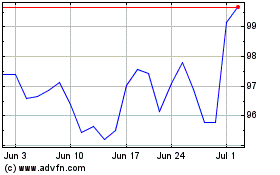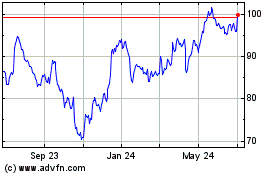Morgan Stanley Profit Rises 3% -- Update
October 17 2019 - 9:22AM
Dow Jones News
By Liz Hoffman
Morgan Stanley's third-quarter profit rose 3% from a year ago,
the last major U.S. bank to skate through a period of global
tensions and shifting markets.
The bank on Thursday reported a profit of $2.17 billion, or
$1.27 a share, on $10.03 billion in revenue, well above what
analysts had expected. Shares rose 4% in trading before the market
opened.
Analysts polled by FactSet had expected a profit of $1.83
billion, or $1.11 a share, on $9.59 billion in revenue. Morgan
Stanley picked up about 6 cents a share in earnings thanks to a tax
benefit; pretax profits were 5% lower than a year ago.
"Overall we remain cautious today, as trade talks swirl and
interest rate paths continue to be debated," Chief Executive James
Gorman said. "But expect us to look beyond the next few
months."
Morgan Stanley is the last of the big U.S. banks to report
earnings for the third quarter, a stretch in which two Federal
Reserve interest-rate cuts and growing global tensions upended the
relative calm and easy financial policies that have helped banks
thrive in recent years.
The results were mixed: Profits rose at JPMorgan Chase & Co.
and Citigroup Inc., driven by strong consumer-banking businesses.
Goldman Sachs Group Inc., Bank of America Corp. and Wells Fargo
& Co. posted lower profits, though the drops at the latter two
owed largely to one-time charges.
Morgan Stanley's return on equity, a measure of profitability,
was 10.7% for the quarter, accounting for the tax benefit, versus a
range of 9% to 15% at peers that have already reported.
Mr. Gorman, in the job since 2010, has transformed Morgan
Stanley from Wall Street's problem child into one of its steadier
performers. He cut costs, shrank the firm's trading division, and
doubled down on wealth management, a steadier business that now
accounts for nearly half of Morgan Stanley's revenue and ties up
little of its capital.
Post-turnaround, Mr. Gorman has sounded more acquisitive in
recent months but must contend with skeptical investors. Morgan
Stanley's shares are among the worst-performing among the biggest
U.S. banks this year, up 7% versus a 15% rise in the KBW Nasdaq
Bank Index.
On Thursday, he continued a long-running gripe with regulators:
that they haven't given Morgan Stanley credit for its turnaround.
"One ongoing challenge of our continued pursuit of higher [returns]
has been the amount of equity we're required to hold," he said.
Morgan Stanley's wealth-management division reported $4.36
billion in revenue from the $2.6 trillion it manages. Its nearly
16,000 brokers have pivoted from plugging stocks earning trading
commissions to charging a flat fee to advise people on where to
invest their money.
It also has benefited from a decadelong bull market, which
pushed up the value of clients' portfolios and the fees the bank
can collect for managing them. The division is getting more
efficient: Its pretax profit was up 4% on revenue that was
essentially unchanged.
Revenue from investment banking rose 5% from a year ago as a
funk settled over what had been a red-hot run for stock offerings.
Equity underwriting fees fell 9%, with Chief Financial Officer
Jonathan Pruzan citing a "notable decline" in IPOs, and were offset
by a rise in revenue from mergers and debt placements.
The firm's trading revenue rose 10%, in line with peers
including Goldman Sachs and Bank of America. Fixed-income trading,
which includes debt, commodities and currencies, rose 21%, while
stock trading, a key business for Morgan Stanley, was roughly
flat.
The firm's smallest division, money management, reported revenue
of $764 million, up 17% from a year ago. Assets ticked up 2% from
the end of June, to $507 billion, as an influx of short-term
money-market assets balanced out lower stock market prices. Growing
that division is a priority for Mr. Gorman.
Write to Liz Hoffman at liz.hoffman@wsj.com
(END) Dow Jones Newswires
October 17, 2019 09:07 ET (13:07 GMT)
Copyright (c) 2019 Dow Jones & Company, Inc.
Morgan Stanley (NYSE:MS)
Historical Stock Chart
From Mar 2024 to Apr 2024

Morgan Stanley (NYSE:MS)
Historical Stock Chart
From Apr 2023 to Apr 2024
